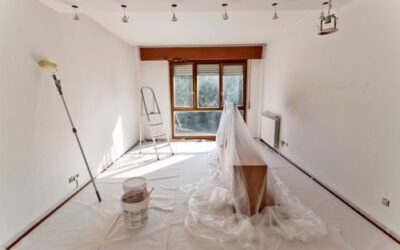Selecting the right paint for interior walls may seem simple, but in reality, there are several important considerations that can influence the final result. From the type of paint to the preparation of the walls, each step is crucial to achieving a finish that is not only aesthetically pleasing, but also durable.
Contact our professionals to paint the walls of your home
Step 1: Explore different paint types
The first important decision is to choose the type of paint that best suits your needs and your home environment.
- Plastic (acrylic) paint: This is the most common type of paint used in interiors. It offers excellent durability, is water-resistant and dries quickly, making it easy to clean and maintain. It is ideal for living rooms, hallways and bedrooms.
- Tempera paint: Although less durable than plastic paint, tempera paint is a good choice for ceilings and walls in areas that do not require frequent cleaning. Its matte finish helps to hide surface imperfections.
- Satin paint: If you’re looking for a finish that offers a light sheen and is easy to clean, satin paint is an excellent choice. It works well in kitchens and bathrooms, where moisture resistance is crucial.
- Chalk paint: Perfect for creating a vintage or rustic effect on walls or furniture, this paint has a matt finish and is mainly used for decorative projects.
Each type of paint has its own advantages and suits different needs, so it is important to consider the specific use of the room before making a decision.
Step 2: Decide on the finish according to your needs
The paint finish significantly influences the final look of the room and how the surfaces are perceived.
- Matt: This finish is ideal for hiding imperfections on walls, as it does not reflect much light. It is perfect for bedrooms and ceilings, where frequent cleaning is not required. However, it is not as hard-wearing as other finishes, so it is not ideal for high traffic areas.
- Satin: Offers a soft sheen that is more resistant to dirt and easy to clean. It is a popular choice for children’s rooms, kitchens and bathrooms, where the combination of durability and ease of cleaning is essential.
- Gloss: Although less common on walls, this finish is extremely durable and easy to clean, making it ideal for mouldings and doors. However, it can highlight imperfections in walls, so it is best used on smooth, well-prepared surfaces. Choosing the right finish can make the difference between a successful painting project and one that needs constant touch-ups.
Step 3: Preparation and paint application
La preparación es la clave para un acabado duradero y de alta calidad. Estos son los pasos esenciales que debes seguir:
- Cleaning: Before painting, make sure the walls are clean and free of dust, grease and other debris. This will ensure that the paint adheres properly and is applied evenly.
- Repair: Fill any cracks, holes or imperfections in the wall with putty and sand the surface once dry. This will provide a smooth base for the paint and improve the final appearance.
- Primer: If you are painting on a new wall or a surface that has been repaired, it is advisable to apply a primer. This helps seal the surface and provides better adhesion for the final paint.
- Application: Use high-quality brushes for edges and details, and a roller for larger areas. Apply the paint in thin layers, starting from the corners and moving towards the centre of the wall. Depending on the type of paint and colour chosen, you may need to apply two or more coats to achieve full and even coverage.
Step 4: Additional tips for a perfect finish
To make sure the end result is the best possible, consider these additional tips:
- Colour test: It is advisable to test a small sample of paint on the wall before painting the entire room. This will allow you to see how the colour looks in different lighting conditions, both natural and artificial.
- Proper tools: Investing in quality tools, such as brushes, rollers and trays, can make a big difference to the final finish. Good quality tools apply paint more evenly and make the painting process easier.
- Ventilation: Make sure the room is well ventilated while painting and during drying. This will not only help the paint dry faster, but will also reduce the smell of paint.
- Maintenance: Once the paint is dry, consider applying a protective sealer to high traffic areas or walls that may be exposed to stains. This will help prolong the life of the paint and keep the walls looking good for longer.
Professional interior painting
While painting interior walls may be a project you decide to undertake yourself, enlisting the help of professional painters can make a big difference, especially if you’re looking for a flawless, long-lasting finish. Professionals have the experience and tools to tackle even the most difficult surfaces and ensure the job is done efficiently. They can also offer personalised advice on the best types of paint and finishes for each space in your home.
Other publications that may interest you
Paint suitable for basements and poorly ventilated rooms
Basements, storerooms or garages have unique conditions: poor ventilation, high humidity and increased risk of mould or condensation. Using conventional paint in these spaces is a common mistake that leads to ephemeral finishes and health problems due to fungi or...
How often should a house be painted depending on its use?
The frequency with which you should paint a house is not always the same. It depends on several factors: the use given to each room, the quality of the paint used, exposure to light or humidity, and even the colour. In this guide we explain how often you should renew...
Tips for painting a room without staining doors and sockets
Painting a room may seem like a simple task, but without the right preparation it's easy to end up with splashes on doors, sockets, switches and even skirting boards. If you want a clean, professional finish, we've got the best tips to avoid stains and save you...




